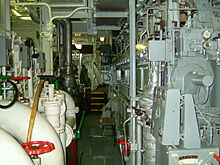Ship engine
A ship's engine is used to drive (mostly propulsion) a watercraft ( ships , boats , submarines, etc.). The speed of the ship is regulated via the speed or the pitch of the controllable pitch propeller .
species
The pioneers of ship engines included gas engines and hot-bulb engines, which today, however, only play a minor role or no longer play a role. The following motors are available, depending on the fuel used in the ship's propulsion system :
- Gas engine
- Glow head motor
- Electric motors , either as a diesel-electric drive or powered by batteries and possibly solar cells on the deck
- Steam engines
- Steam engines
- Steam turbines
- Combustion engines (see also marine diesel engine )
- Gas turbines
- Magnetic hydrodynamic drive (so far not very successful, e.g. in Japan)
- Water jet propulsion
- Fuel cell
The motors can be mounted in the ( inboard motor ) or on the vehicle ( outboard motor ). With internal engines, the torque is transmitted to the propeller , the paddle wheel, a generator or the jet drive via a propeller shaft . There are also ships with external, pivoting propeller nacelles , in which an electric motor is located in the nacelle. In air-cushion boats, the propeller does not work in the water, but in the air .
- Marine propulsion engines
- Major manufacturers of large engines ( diesel engines )
- Caterpillar
- Deutz AG
- MAN Diesel (MAN Energy Solutions)
- MTU Friedrichshafen
- Wärtsilä
- SEMT Pielstick
- Major manufacturers of small engines are listed in the article boat engine .
- Major manufacturers of large engines ( diesel engines )
- Auxiliary engines
- Bow thruster system (auxiliary control by means of a water jet)
- Drive the generators for the entire ship's electrical system
Energy sources
- Heavy oil , orimulsion
- Diesel fuel
- petroleum
- petrol
- Methanol
- Natural gas , town gas
- coal
- Nuclear energy (on some nuclear ships , nuclear submarines , nuclear icebreakers and a few civilian ships )
- Electricity in the electric boat
- Solar energy in the solar boat
- Hydrogen (e.g. in the Alster ship with fuel cell drive Alsterwasser )
The electrical energy is generated on board by generators . The generators are driven by diesel engines or by shaft generators, more rarely by gas turbines or steam turbines.
Electric drives with solar generators, which do not have to carry primary energy with them, but mostly have accumulators for buffering (previously small ships or ferries for short distances), occupy a special position.
The generation of electricity from hydrogen in fuel cells is an interesting option for submarines, as it avoids high-speed pumps, high temperatures and dangerous physical processes (compared to nuclear reactors ). It is used in the submarine class 212 A built in Germany .
Steam can be generated, for example, by nuclear reactors (ships with nuclear drive), coal firing (today only museum ships), oil or gas firing (only gas tankers).
See also
literature
- Full speed ahead: the development of drive technology . In: Schiff & Hafen , issue 12/2009, pp. 14–21. Seehafen-Verlag, Hamburg 2009, ISSN 0938-1643
- Hans-Jürgen Reuß: 125 years of motor shipping . Insert in: Hansa , issue 4/2011, Schiffahrtsverlag Hansa, Hamburg 2011, ISSN 0017-7504
- Günter Ackermann, Karl-Heinz Hochhaus: Electrical systems on ferry and cruise ships . In: Hansa , Heft 3/2012, pp. 42-48, Schiffahrts-Verlag Hansa, Hamburg 2012, ISSN 0017-7504
Web links
Individual evidence
- ↑ https://hochhaus-schiffsbetrieb.jimdo.com/neue-brennstoffe/ published in April 2019 in the specialist journal “Schiffsbetriebstechnik Flensburg” No. 1/2019; Future, shipping with CO2-neutral fuels, accessed on May 20, 2019



